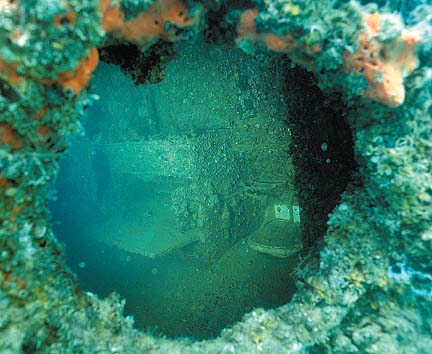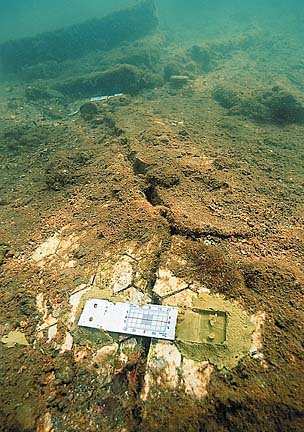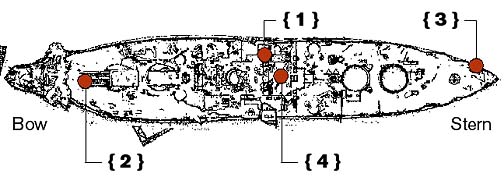

[ PEARL HARBOR / FADING VOICES ]

|
Saving the Arizona Shattered, blazing, the USS Arizona settled into the bottom mud of Pearl Harbor on Dec. 7, 1941, carrying with it more than half the casualties of the attack.
Balancing restoration efforts
with respect for the dead
presents a delicate dilemmaBy Burl Burlingame
bburlingame@starbulletin.comAttempts to salvage the ship were futile. Navy and civilian divers pulled off any parts that could be reused, working in a wet horror of oil, debris and rotting bodies, and eventually called a halt to it in 1943.
No one stood on the deck of the Arizona again for four decades, when the National Park Service began a series of regular dive surveys in 1983 to assess the ship's condition.
Given the task of operating the USS Arizona Memorial, the ranger historians and scientists of the NPS had no idea what they had been handed.

|
"The USS Arizona Memorial holds a unique place in American culture," notes Edward Tabor Linenthal, professor of religion and American culture at the University of Wisconsin, Oshkosh, and author of "Sacred Places.""It's a shrine, it's a historic site, it's a tomb. It's sacred for all of those reasons. Unlike places on land that are clearly delineated, here you have a site under water that's a part of American culture."
"The Park Service has an incredibly difficult task," explained Linenthal. "The ship's been sitting in the water since 1941 and it's degrading -- but if you enter the ship to do restorative work of any kind, you're intruding into a grave site. If you leave it alone to be respectful, you're guilty of defilement by neglect. It's a difficult position to be in!"
"For the first time, people involved with the stewardship of the site could grasp what was there," Dan Lenihan of the NPS Submerged Resources Center (SRC) explained to a History Channel team for "Save the Arizona!"
"For the first time, we could get a sense there were problems with the site, particularly in the way of holding that much petroleum products -- as a battleship would -- could have long-range consequences for the environment."
"The next question was -- what's happening down there?" wondered SRC underwater archaeolgist and chief Larry Murphy. "And that became a very, very complex question we're still dealing with today."
Exploring the Arizona
|
The 1983 dives revealed the scope of the ship's damage. Subsequent dives charted deterioration in increasingly sophisticated ways.In 1998, metallurgists from the University of Nebraska at Lincoln volunteered to study metal samples from the Arizona.
"Save the Arizona!" executive producers Lynn and Nick Krantz were impressed by the dedication of the Nebraska scientists, who also worked on the submarine Hunley and other historic steel structures.
"Here were old guys who had never been closer to water than a bathtub in their lives, and they were training in 17-foot deep ponds," marveled Nick Krantz. "They became obsessed with the project."
Professor Don Johnson -- who was 14 when the Arizona sank -- explained that their "objective has been to assess how does corrosion occur on the structure, and how do we evaluate the corrosion rate? We want to pass this information to the Park Service and from that, they can make their decisions."
Data dives on the Arizona are now made annually. "Biofouling" such as barnacles and coral and seaweed are removed in selected locations and the hull precisely measured.
Divers have made an ethical pact with themselves not to enter the interior of the battleship, and instead send in a Remote Operated Vehicle to scout around. The sanctity of the tomb is on their minds.
"We'll be working with the ROV, just taking measurements, just looking at a bulkhead -- and then we'll swing by a closet and see a uniform just hanging there," unmoved since 1941, said Murphy.
"There's an immediate human connection that's just remarkable, and it happens every single time. Sure, there's scientific data to be gathered from that -- a uniform that has remained (intact) in an area of oxygenated sea water indicates that preservation is really pretty good."
Sometime in the next five years, scientists and Park Service officials will issue their report on the battleship's stability, and what should be done to preserve it.
Preliminary indications are that the ship is in better shape than they thought. "For being 60 years in the water with nothing being done, it's nowhere near the point of collapse," said engineering professor William Weins.

|
Weins passed away a few weeks ago, and the documentarians dedicated their work to his memory.They also point out in some places, the metal of the ship has vanished, leaving behind only the biofoul coating. "Only the biofoul is holding the oil in," said Krantz.
Historian James Delgado, an original Park Service diver on the Arizona, has a different theory. He speculates that the oil, when mixed with seawater, has become mildly corrosive, and that the ship is being eaten from the inside out.
Even if the ship doesn't fall apart right away, rangers are worried about the estimated half-million gallons of oil still aboard the ship. About a quart a day bubbles to the surface.
But if the area where the oil is were to collapse, suddenly releasing that much oil in Pearl Harbor would be an ecological disaster.
One of the questions remaining to be answered about the shattered hulk of the Arizona is where the oil is hiding.
"We know that at one time the ship's bunkers held all the oil, but that a lot of those bunkers are compromised," Lenihan said. "Where did the oil go? We think that a lot of it is pooled in the overheads, up succeeding decks as it comes to the surface."
"We're going to have to come up with at least tentative management options for the ship in the next couple of years, especially if there's an increase in seepage of oil from the ship," said USS Arizona Memorial superintendent Kathy Billings. "We need to do something about that. We can't let that continue to threaten the harbor."
Options include building a cofferdam around the ship -- hugely expensive and dismissed even in 1941 -- or high-tech solutions such as cathodic protection, in which anodic metals with a higher galvanic response to sea water, such as zinc, are "sacrificed" to preserve the Arizona's steel.
Cathodic protection "never has been done on a vessel that's 60 years old," said Lenihan. "That's assuming a decision has been made to intervene in the natural deterioration process."
That right, one decision would be to do nothing. "Leave the USS Arizona alone -- that would be the natural course of life for a relic like this; it has a life span and one respects that life span," said Linenthal. That said, "I think it would be very unpopular for this option to be chosen. In preserving the USS Arizona, we say something about our own moral capacity in a very profound way, and our willingness to act upon it."
The National Park Service's Submerged Resources Center and the USS Arizona Memorial Association graciously provided the underwater images and artifacts, respectively, that appear throughout this special section. The Honolulu Star-Bulletin is grateful for their assistance. Special thanks